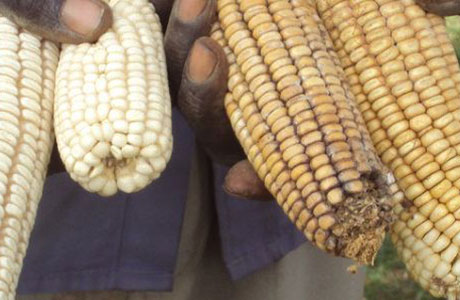Faculty members combat crop molds in kids’ diets
By Sheri Englund

Malnutrition is responsible for more than two million children’s deaths annually, and too little food is not the only problem. Sometimes even adequate diets – rich in corn and nuts, for instance – aren’t enough to nourish babies and children, when the crops are contaminated before they reach the table.
New studies show that corn and peanuts, common foods in the African diet, often contain harmful mycotoxins produced by molds. When eaten by pregnant women, these toxins may contribute to prematurity and low birth weight, stunting and immune suppression in their babies. The damage continues when young children begin to eat solid foods. Improving how rural farmers grow, harvest and store these crops could dramatically improve health outcomes for some of the world’s most vulnerable children while boosting the safety of the global food supply.
Following a 2008 Academic Venture Fund (AVF) award from the Atkinson Center for a Sustainable Future (ACSF), faculty fellows Rebecca Stoltzfus, Rebecca Nelson and Dan Brown teamed up to solve this puzzle with additional AVF support.
Stoltzfus has a grant from the Bill & Melinda Gates Foundation and another from the National Institute of Environmental Health Science to determine whether and how mycotoxins compromise the health of mothers and babies. Stoltzfus and doctoral student Laura Smith are working with the Sanitation Hygiene Infant Nutrition Efficacy project, a major field trial in rural Zimbabwe, where maize and ground nuts are dietary staples. They recently completed a survey of more than 1,700 pregnant women and found that nearly all of the women frequently eat commonly contaminated foods – and harvesting and storage practices that encourage mold growth are the norm in these rural households.
Two-thirds of the corn and three-quarters of the ground nuts were harvested early or stored in damp conditions that make dangerous aflatoxins grow. More than 30 percent of pregnant women showed aflatoxin metabolites in their urine, confirming widespread consumption of toxic foods. The researchers are assessing whether these moldy foods cause stillbirths, miscarriages, premature delivery and stunting of infants.
In Eastern Kenya during an outbreak in 2010, Nelson’s group confirmed the presence of mycotoxins, including aflatoxins and equally dangerous fumonisin, in more than a third of samples. In some communities, as much as 60 percent of corn was contaminated, and the problem was most acute with crops from smallholder farms. Findings from the study, supported by the Atkinson Center, were recently published in the journal Phytopathology.
The international research effort involves researchers in East Africa at work on improving the safety of the local diet. Two Kenyan scientists, Samuel Mutiga and Francis Ngure, contributed to Cornell’s aflatoxins research as doctoral students working with Nelson and Stoltzfus. Mutiga, now at the International Livestock Research Institute (ILRI), collaborated with Nelson and plant pathologist Michael Milgroom on an ACSF-funded project that helped start a thriving mycotoxin lab at ILRI’s Biosciences Eastern and Central Africa hub in Nairobi.
With funding from another Gates Foundation grant, Nelson and Stoltzfus are designing a large field trial of a strategy to reduce these toxins in the diets of pregnant women and their babies. During the planning period, they will decide on an African site, as well the strategy for intervention. Plant researcher Nelson and others are developing intervention strategies for small-scale farmers that promise to reduce outbreaks of the crippling mold.
Sheri Englund is science writer and editor at Cornell's David R. Atkinson Center for a Sustainable Future.
Media Contact
Get Cornell news delivered right to your inbox.
Subscribe